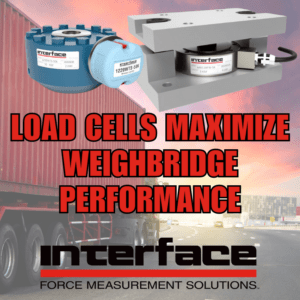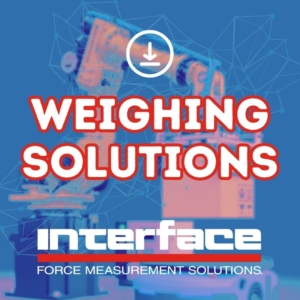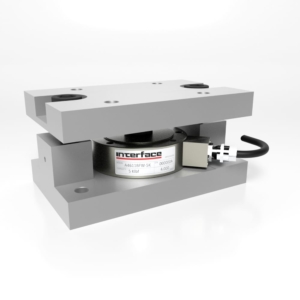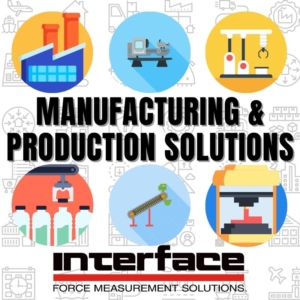Load Cells Maximize Weighbridge Performance
 What is a weighbridge? By definition, a weighbridge, also known as a truck scale or weight scale, is a large, heavy-duty platform scale used to weigh vehicles and their cargo. They are typically found in industrial settings where large or commercial vehicles, cargo, and various materials must be weighed.
What is a weighbridge? By definition, a weighbridge, also known as a truck scale or weight scale, is a large, heavy-duty platform scale used to weigh vehicles and their cargo. They are typically found in industrial settings where large or commercial vehicles, cargo, and various materials must be weighed.
Weighbridges come in all shapes and sizes and measure the weight of various products. The heart and soul of a weighbridge is a sensor that provides the user with accurate weight data.
Traditional weighbridges often rely on mechanical components that can wear down over time, leading to slight inaccuracies. Interface load cells are incredibly precise and deliver highly accurate weight readings, even with constant use. This minimizes errors in measurements, ensuring reliable data for every weighbridge operation.
One of the most common weighbridge applications using load cells is measuring large trucks at weigh stops on highways and in transport centers. However, weighbridge load cells are used in weighing applications for railways, waste containers, supermarket scales, warehouses, test benches, heavy-duty equipment, and industrial scales.
Typical Weighbridge Use Cases
- Compliance with weight limits: Many countries regulate transportation, including a vehicle’s maximum weight. For example, weighbridges ensure that trucks are not overloaded, which can damage roads and bridges and be dangerous.
- Shipping costs: Weighbridges are used to weigh shipments to calculate accurate shipping costs.
- Track inventory: Warehouses, shipyards, manufacturers, and distribution companies can use weighbridges to track their inventory by weighing incoming and outgoing goods.
- Waste disposal: Weighbridges can weigh waste materials during landfill disposal by automating equipment to manage waste.
Our load cells support many weighbridge applications because we supply highly accurate and reliable force sensor technologies commonly used in weighing applications across all industries. We understand weighing sensors must be highly accurate and reliable to ensure precise data. Check out our weighing solutions guide to help select the right measurement device for your application.
Interface weighing solutions that make an excellent fit for weighbridge applications include:
- LowProfile® Load Cells
- Platform Scale Load Cells
- WeighCheck™ Load Cells
- Indicators
- Weighing Instrumentation
- Wireless and Bluetooth Sensors and Accessories
Top Five Benefits of Precision Load Cells For Weighbridges
#1—Precision load cells offer superior accuracy to traditional mechanical weighbridge systems. This minimizes errors in weight measurements, ensuring reliable data for transactions, compliance checks, and inventory management.
#2—Reliability is vital in these applications. Interface load cells deliver consistent weight readings even with repeated use. This allows for dependable performance, which is crucial for tasks like batching or monitoring materials.
#3—Unlike mechanical systems with moving parts, precision load cells are reliable instruments that increase lifespan and reduce maintenance costs and downtime for weighbridge operations.
#4—Precision load cells offer a broader range of weight capacities. This allows a single weighbridge with these load cells to accommodate various vehicle sizes and weights, offering greater flexibility.
#5- Interface offers a range of highly durable load cells designed to withstand harsh industrial environments, ensuring long-lasting performance and reliable weight measurements.
Truck Weighbridge Solution
A customer owned a truck company and needed to record the weight of loads being carried by their trucks. They wanted a wireless weighing bridge to transmit, log, and display the results in real time. Interface suggested installing multiple WTS 1200 LowProfile™ Load Cells under a weighing bridge. When the truck drives over it, the load cells transmit the force results wirelessly to the WTS-BS-4 Industrial Base Station connected to the customer’s PC with the provided Log100 software. The WTS-LD2 Wireless Large LED Display also displayed the weight inside for the driver to see in real-time. Using this solution, the customer successfully measured, logged, and graphed the different loads their trucks carried wirelessly onto the weighbridge.
Interface has also seen applications, including the use of weighcheck load cells in machinery for bag filling, bottle filling, high-speed check weighers, multi-head packing machines, silo and tank weighing systems, and conveyor scales.
Interface is the perfect force solutions partner for weighbridge applications across industries. To learn more about these solutions for weighbridges and other weighing applications, please visit our Weighing Solutions Overview and Applications.
ADDITIONAL RESOURCES
Timber Weighing and Harvesting
Load Cells for Smarter and More Efficient Weighing

 Interface A4600 WeighCheck™ Load Cells in stainless steel and A4200 WeighCheck Load Cells, which is zinc plated, are both high accuracy force measurement weighing solutions. Manufactured and designed by Interface engineers, these exclusive Interface products are specifically designed for tank weighing, where it is necessary to accommodate expansion and contraction of the tank. Interface has expanded with new model options that include signal conditioning features, including customized IO-Link Digital and 3-Wire options. The newly introduced customized A4200 and A4600 3-Wire Amplified Load Cells provide an internally amplified low profile load cell with a voltage or mA signal. This option eliminates the need for an external signal conditioner and comes scaled to the load cell and ready to use.
Interface A4600 WeighCheck™ Load Cells in stainless steel and A4200 WeighCheck Load Cells, which is zinc plated, are both high accuracy force measurement weighing solutions. Manufactured and designed by Interface engineers, these exclusive Interface products are specifically designed for tank weighing, where it is necessary to accommodate expansion and contraction of the tank. Interface has expanded with new model options that include signal conditioning features, including customized IO-Link Digital and 3-Wire options. The newly introduced customized A4200 and A4600 3-Wire Amplified Load Cells provide an internally amplified low profile load cell with a voltage or mA signal. This option eliminates the need for an external signal conditioner and comes scaled to the load cell and ready to use. Force measurement is integral to
Force measurement is integral to 
